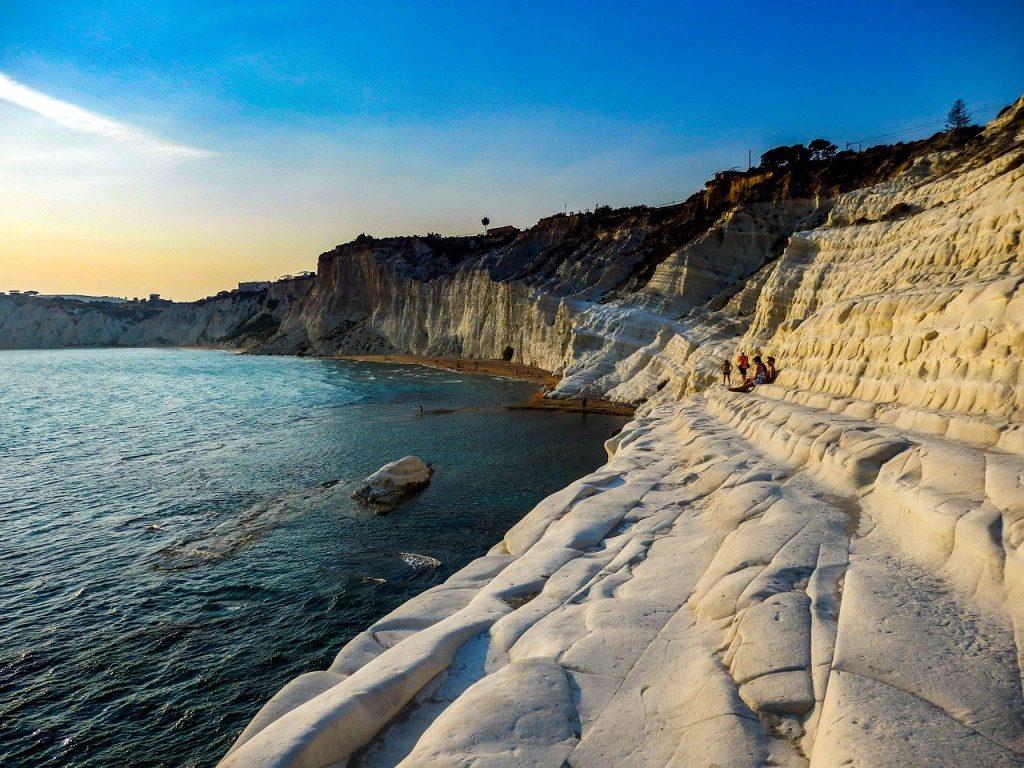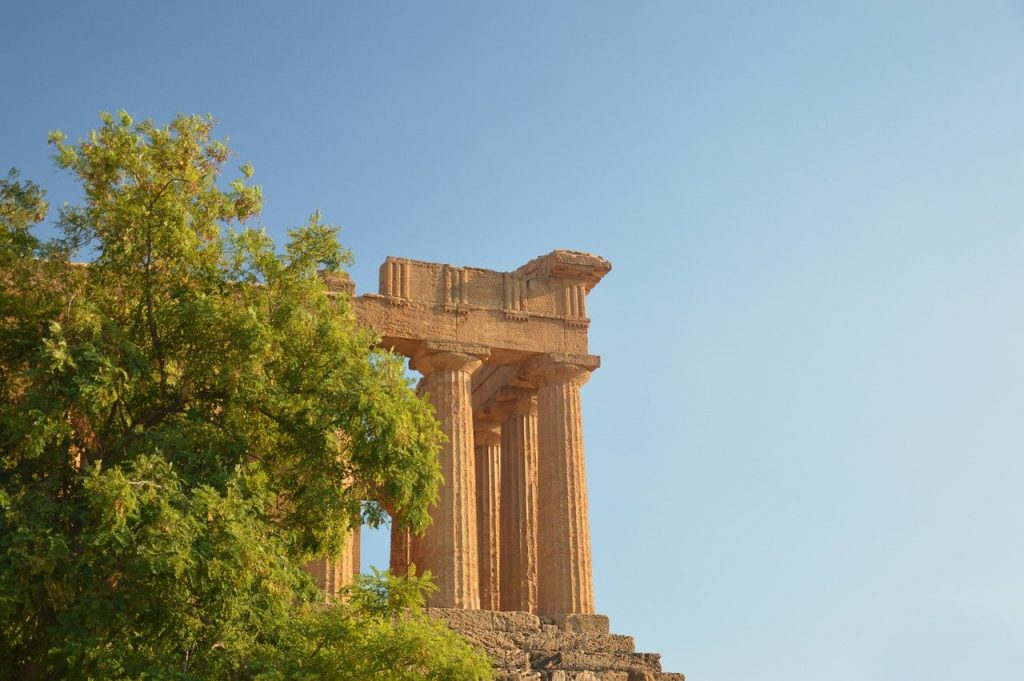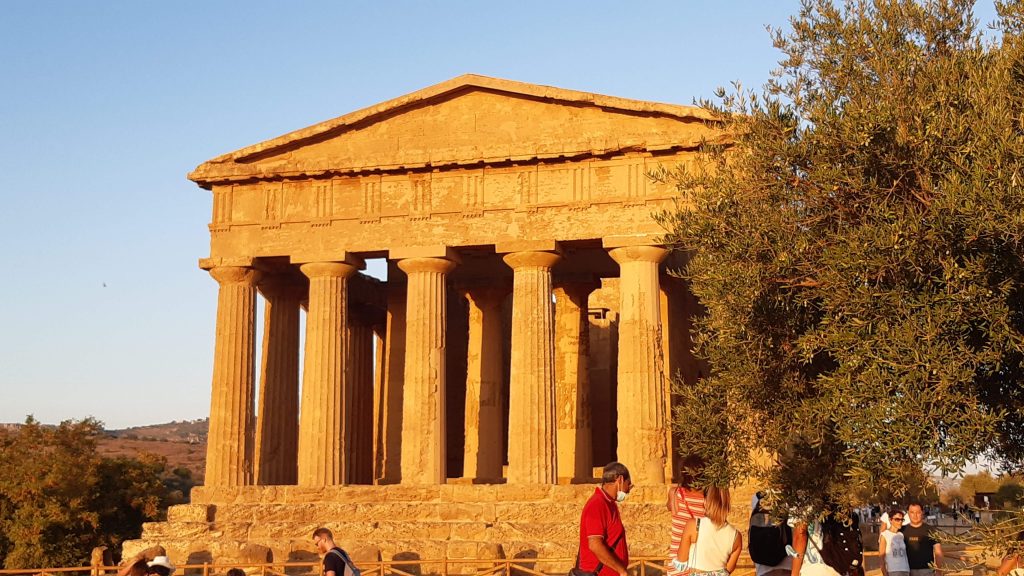A tour of Sicily: Exploring South West Sicily
On the first stop of our tour of Sicily, we experienced some of Sicily’s most peculiar characteristics. However, if Baroque towns and delicious granita were not enough for you and you want to find out more about the history and beauty of this island, then don’t miss our second stop where you will take a real jump back in time!
2nd Stop: The South-Western Coast – The Door to the Mediterranean
Leaving the province of Syracuse and heading west, we leave the clear Ionian Sea behind and instead find ourselves met by the wide open Mediterranean Sea. This sea has been a real door into other cultures that for centuries have shaped the whole of Sicily (and this Southern coast in particular). Here you will find some of the most stunning beaches of the island and one of the most famous seaside spots that actually references past fights and cultural exchanges in its own name.

Scala dei Turchi is a majestic white cliff with the shape of a giant staircase, which dives into crystal clear waters and whose name literally means ‘Stair of the Turks’. The name Turkish Steps refers to the frequent invasions of Saracen pirates, who usually anchored their boats in this peaceful bay away from the winds of the open seas and who were generally called ‘Turks’ by the local people. According to legend, the pirates used to climb the cliff as a real staircase to reach the upper land and plunder local villages. Today, the site is one of the most charming spots in the entire island and a real must-see for all sea and sunset lovers! Its international fame is also due to the many films that were shot here, making the cliff the perfect location for stories about love and rural Sicily such as in the world-famous ‘Malena’ by Giuseppe Tornatore.
Once near the Scala dei Turchi you will probably feel like you could be starring in a film… although admittedly you may need to block out the other tourists to do so! While the spot is usually empty as a film location, in real life and especially during the Summer months, people from all over the world are drawn here by the beauty of the white cliffs and the incredible chromatic contrast it has with the blue of the sea.
In order to protect the site from the negative impacts of mass tourism and to preserve its fragile structure, local authorities have introduced a ban on the cliff and it is now forbidden to sit on it or to climb it. The decision is part of a bigger protection scheme for the site, which led to its nomination to be included in the UNESCO World Heritage List last year. A visit to Scala dei Turchi therefore requires tourists to be careful and to remember the great geological and historical importance of the site while still enjoying it.
If climbing the cliff is now forbidden, the nearby beaches are still open. At the Lido Rossello you will find a sandy beach with a great view of the entire site, but if you want to get closer to the imposing Scala then I suggest you follow the path near to the restaurant Lido Scala dei Turchi to reach the rocky beach next to it. With its white rocks sloping gradually into the clear waters this is the perfect place for relaxing and sunbathing and from here you can even have a swim just beneath the main cliffs!

About 20 minutes away from the Scala and the beautiful coastline is Agrigento, the main city of the area. Set on a green hill facing the sea, the historical centre is called Girgenti, which had been the name of the entire town for centuries before local authorities decided to change it and to recall the ancient Latin name of Agrigentum. Its maze of small streets and squares still carry signs of the Arabic and Norman reigns, especially in the architecture of its numerous churches and historical buildings. Some interesting sights include the San Gerlando Cathedral and the Piazza Pirandello, named after the great Italian dramatist and poet, one the city’s most famous sons.
Like Syracuse and Ragusa, this town is another example of the cultural mixture of the island, but one thing in particular left a significant mark here, and it is what the name Agrigento is now famous for worldwide. Known as the Valley of the Temples, the hill next to the city centre is the place where the original Greek settlement of Akragas was founded and today it is still home to one of the most impressive agglomerations of Doric temples and Classic ruins in the world. Part of the UNESCO World Heritage List since 1997, the Valley is Agrigento’s biggest treasure and for sure an unmissable site to visit in this area of Sicily. Akragas was described by the Greek poet Pindar as the ‘most beautiful city of those inhabited by men’ and it is not hard to understand why! During its most prosperous time, the Greek city reached a population of 200,000 inhabitants with an imposing 12 kilometre long defence wall and 9 gateways. A complex system of canals and tunnels provided the city with water, which was collected in the giant artificial basin of Kolymbethra, now part of the archaeological area and home to one of the most beautiful and flourishing parks of Italy. In this huge garden you can take a stroll whilst admiring the most diverse examples of Mediterranean forest, citrus trees and centuries old olive trees. On top of the hill is the ancient holy area, the heart of the religious and social life of Akragas and now the main focus of the visit. The long path will lead you through the ruins of the Temple of Castor and Pollux, the symbol of Agrigento, and the Temple of Olympian Zeus, the biggest Doric temple in the entire Greek world. Even though the basement is the only part of the building still preserved today, you can easily imagine the imposing façade of the ancient temple thanks to its high steps and the ruins of Atlas, one of the giant statues that were placed between the columns. The main attractions of the archaeological park are then the two final buildings: the Temple of Concordia, the most well-preserved one thanks to its reconversion into a Christian church during Medieval times, and the Temple of Juno with its incredible location on top of a rocky spur, from which you will enjoy an amazing view on the entire valley.

Walking through imposing ruins and citrus trees and having a break in the shadow of huge columns will surely bring you back in time and let you feel the great ancient splendour of Akragas before its destruction which was perpetuated by the Carthaginians. The archaeological park is open until midnight during Summer months (and until 8 pm during winter months), so I suggest you visit the area late in the afternoon or just before the evening starts. Watching the sunset through the ancient columns and seeing the temples gradually taking on a warm orange hue is, for sure, a once-in-a-lifetime experience!
The South-Western coast of Sicily is a place full of history and natural beauty, a real gateway to all the different cultures that have been developing on the shores of the Mediterranean for centuries. Just like it has done for centuries, it is still welcoming everyone coming from the sea today. This little tour would probably take one or two days, a short break of culture and relax before heading north to our last unmissable stop in Sicily!
Another huge thank you goes to Domiziana Lecci who contributed this article for the Bookings For You blog. Domiziana spent the Summer of 2018 with the Bookings For You team as part of an internship with the company. She grew up in Marche, but most recently has lived in Venice as a student before starting work for a big tour operator in Italy in 2019. Unfortunately, COVID has interrupted her career plans but she is keen to continue to work in the travel and leisure sector in the future. Following the lifting of lockdown restrictions this Summer, she enjoyed the opportunity to explore the beautiful island of Sicily and we’re absolutely delighted that she has generously shared her wonderful travel adventures with us and our readers.


